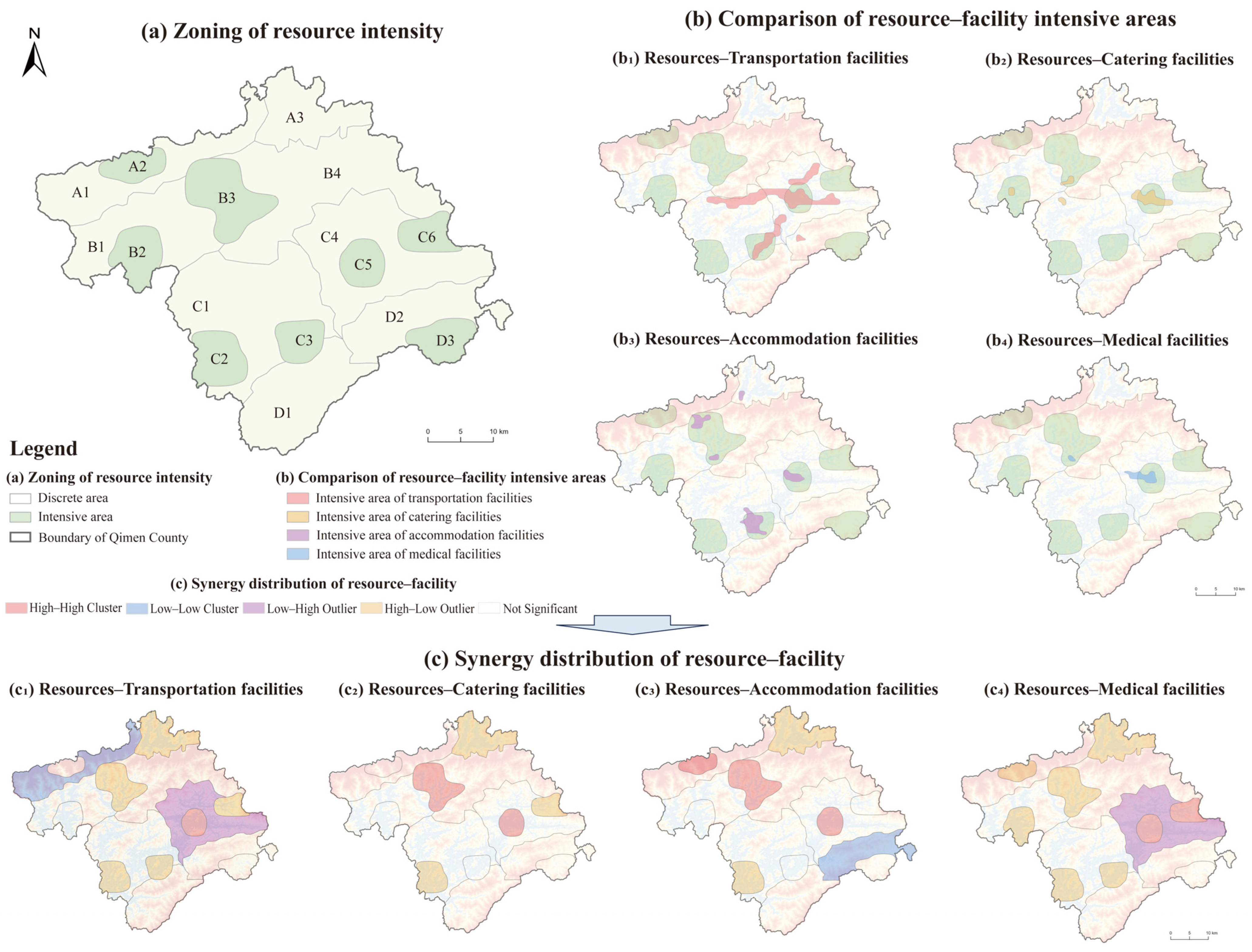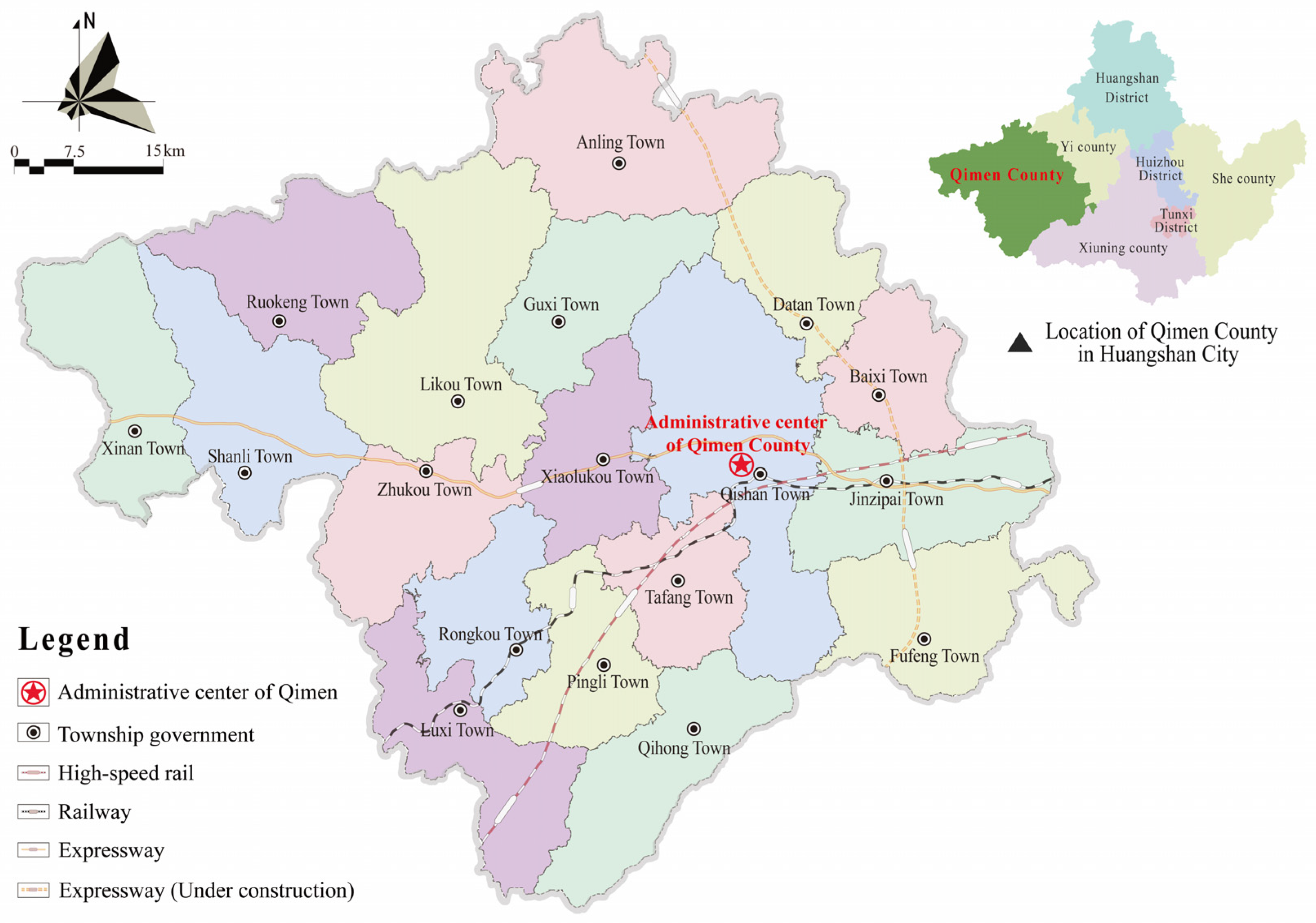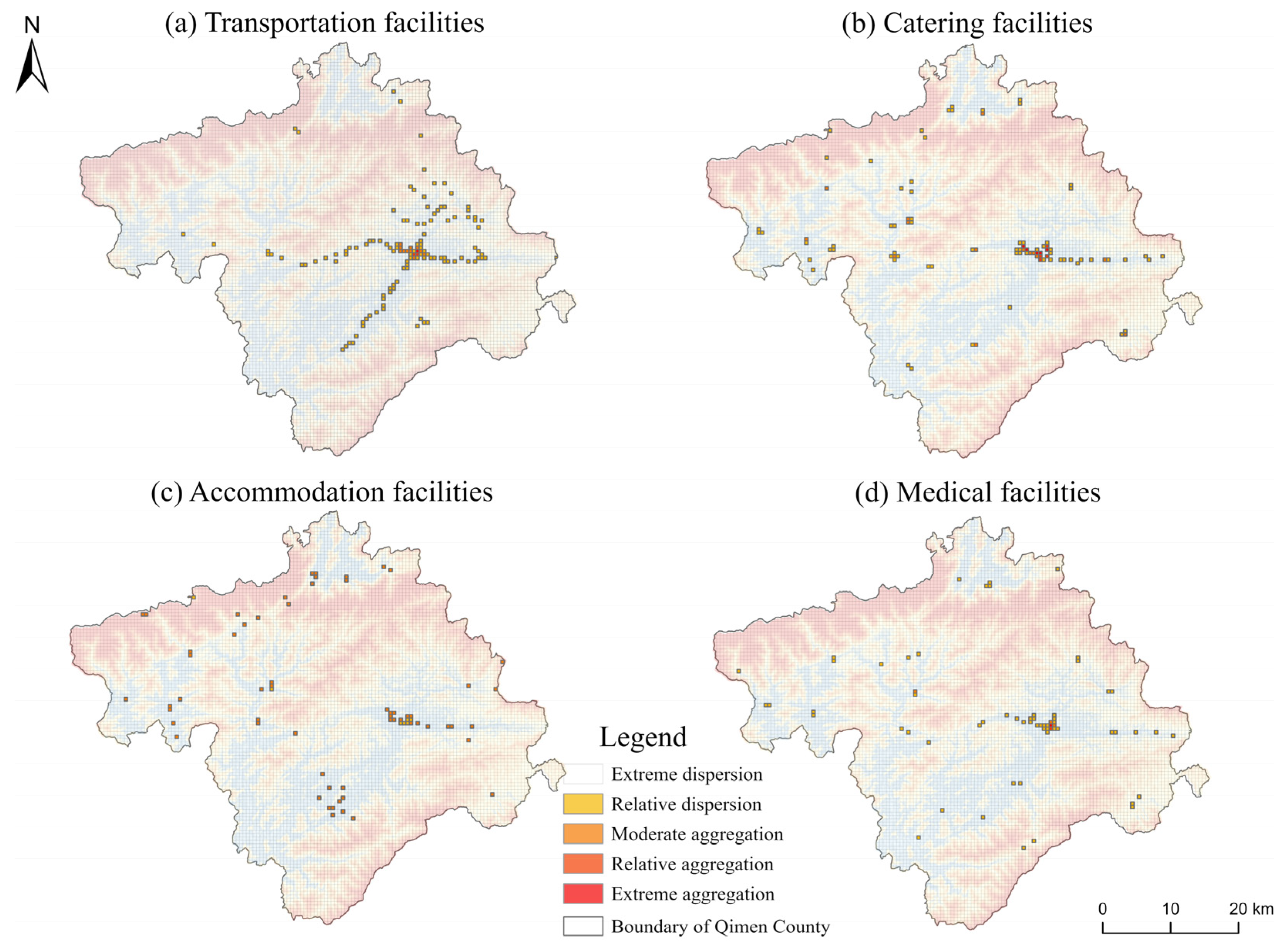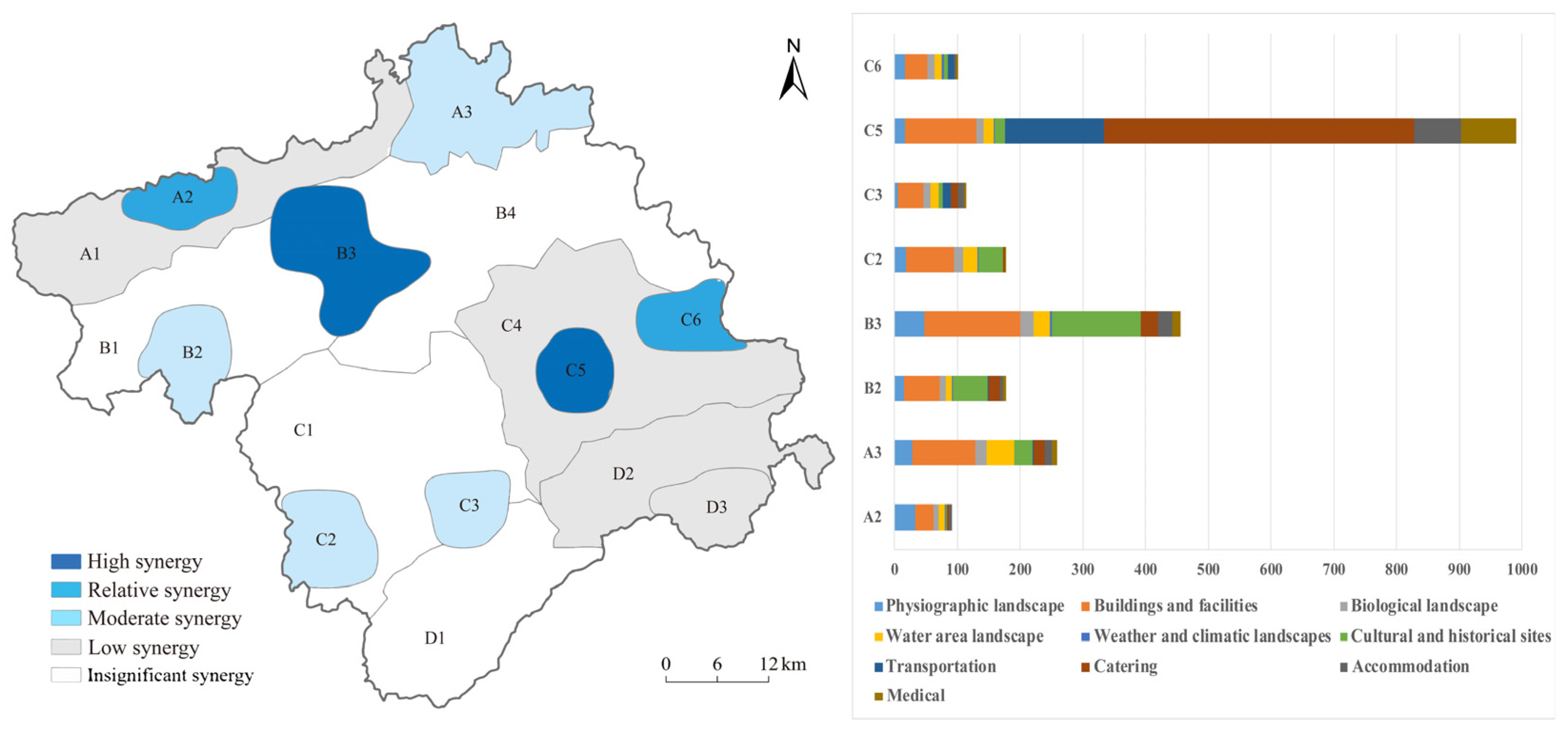Spatial Synergy between Tourism Resources and Tourism Service Facilities in Mountainous Counties: A Case Study of Qimen, Huangshan, China
Abstract
:1. Introduction
2. Materials and Methods
2.1. Study Site
2.2. Research Methodology
2.2.1. Gridding of Tourism Resources and Tourism Service Facilities
- (1)
- Gridding of tourism resources
- (2)
- Gridding of tourism service facilities
2.2.2. Recognition and Extraction of Tourism Resource and Tourism Service Facility Zones
2.2.3. Analysis of the Synergistic Level Pattern between Tourism Resources and Tourism Service Facilities
- (1)
- Overlay analysis of tourism resources and tourism service facilities
- (2)
- Synergistic pattern between tourism resources and tourism service facilities
- (3)
- Synergistic level between tourism resources and tourism service facilities
2.3. Data Sources
- (1)
- Tourism resource data
- (2)
- POI data for tourism service facilities
- (3)
- Basic geospatial data
3. Results
3.1. Distribution Characteristics of Tourism Resources
3.2. Distribution Characteristics of Tourism Service Facilities
3.3. Spatial Synergistic Level between Tourism Resources and Tourism Service Facilities
3.3.1. Spatial Overlay Analysis of Tourism Resources and Tourism Service Facilities

3.3.2. Spatial Synergistic Pattern of Tourism Resources and Tourism Service Facilities
3.3.3. Spatial Synergistic Level between Tourism Resources and Tourism Service Facilities
4. Scenario-Based Comparative Analyses on Altitude and Population Density
4.1. Spatial Synergy Analysis Based on Different Altitude Zones
4.2. Spatial Synergy Analysis Based on Different Population Density Zones
5. Discussion
6. Conclusions
Author Contributions
Funding
Data Availability Statement
Conflicts of Interest
| 1 | https://www.163.com/dy/article/J11P4ANM05521WCW.html, accessed on 23 May 2024. |
References
- Liu, J.; Zhang, X.; Zhang, T.; Yang, Y. Spatial matching relationship between tourist attractions and supporting facilities in Qingdao from the perspective of convenience. J. Nat. Sci. Hum. Norm. Univ. 2023, 46, 28–39. [Google Scholar]
- Liu, J.; Ji, X.; Liu, J.; Zhang, T. Research on matching supply and demand of tourism resources in Jiaodong economic circle based on multi-source heterogeneous data. J. Geo-Inf. Sci. 2024, 26, 393–407. [Google Scholar] [CrossRef]
- Charati, M.K.; Gholian-Jouybari, F.; Hajiaghaei-Keshteli, M.; Paydar, M.M.; Sadeghi, F. Designing a sustainable dental tourism supply chain considering waste treatment. Ann. Oper. Res. 2024, 1–42. [Google Scholar] [CrossRef]
- Ren, Y.; Lu, L.; Han, Y. Research framework of tourism resources from a new perspective of tourism resources. J. Nat. Resour. 2022, 37, 551–567. [Google Scholar] [CrossRef]
- Meng, G.; Wang, K.; Wang, F.; Dong, Y. Analysis of the tourism-economy-ecology coupling coordination and high-quality development path in karst Guizhou Province, China. Ecol. Indic. 2023, 154, 110858. [Google Scholar] [CrossRef]
- Bao, J.; Chen, Y.; Ma, L. The process and mechanism of tourism resources evaluation: From technical evaluation to the social construction perspective. J. Nat. Resour. 2020, 35, 1556–1569. [Google Scholar] [CrossRef]
- Liu, J.; Li, Y.; Lin, C.; Wang, J.; Qiao, Z.; Ge, Q. Spatial pattern of the tourism resources of Yangtze River Tourism Belt. Resour. Environ. Yangtze Basin 2016, 25, 1009–1015. [Google Scholar] [CrossRef]
- Song, X.; Du, L.; Wang, Z. Correlation Analysis of Urban Road Network Structure and Spatial Distribution of Tourism Service Facilities at Multi-Scales Based on Tourists’ Travel Preferences. Buildings 2024, 14, 914. [Google Scholar] [CrossRef]
- Mandić, A.; Mrnjavac, Ž.; Kordić, L. Tourism infrastructure, recreational facilities and tourism development. Tour. Hosp. Manag. 2018, 24, 41–62. [Google Scholar] [CrossRef]
- Chen, W.; Wu, Z. The problems, strategy, and mechanism of integrating cultural and tourist public services. Stud. Cult. Art 2020, 13, 1–12. [Google Scholar]
- Bahar, A.M.; Maizaldi, M.; Putera, N.; Widiestuty, R.; Chaniago, S.; Eliza, Y. The effect of tourism facilities, service quality and promotion of tourist satisfaction in South Pesisir District. J-MAS (J. Manaj. Dan Sains) 2020, 5, 5–9. [Google Scholar] [CrossRef]
- Scotti, F.; Flori, A.; Secchi, P.; Arena, M.; Azzone, G. Exploring drivers of overnight stays and same-day visits in the tourism sector. Sci. Rep. 2024, 14, 9840. [Google Scholar] [CrossRef]
- Zhan, D.; Zhang, W.; Chen, L.; Yu, X.; Dang, X. Research progress and its enlightenment of urban public service facilities allocation. Prog. Geogr. 2019, 38, 506–519. [Google Scholar] [CrossRef]
- Tao, C.; Huang, S.; Wang, J.; Qiao, G. Accessible tourism: Tourists with physical disability-segmentation based on perceived travel barriers. Tour. Rev. 2024. [Google Scholar] [CrossRef]
- Yang, G. The Management of Visitor Attractions; Science Press: Beijing, China, 2006. [Google Scholar]
- Luo, Q.; Chen, S.; Wang, Y.; Li, M. Identification of rural development types and revitalization paths in poor mountainous areas: Taking Luanchuan County, Henan Province as an example. Prog. Geogr. 2022, 41, 1783–1794. [Google Scholar] [CrossRef]
- Sikorski, D.; Latocha-Wites, A.; Tomczak, P.; Szmytkie, R.; Miodońska, P.; Kajdanek, K. Changes in the services of general interest in mountainous areas in Poland over the period 1988–2020: Their types, dynamics and driving forces. Morav. Geogr. Rep. 2023, 31, 39–49. [Google Scholar] [CrossRef]
- Sun, L.; Ming, Q. Spatial distribution characteristics of tourism facilities and analysis of spatial dislocation with tourism resources. Resour. Dev. Mark. 2024, 40, 605–613. [Google Scholar] [CrossRef]
- Gao, Z.; Zhuo, M.; Zhang, Y.; Song, Z. Regional division of spatial synergy between ecological tourism resources and infrastructures on the Qinghai-Tibet Plateau. J. Arid Land Resour. Environ. 2024, 38, 172–181. [Google Scholar] [CrossRef]
- Wen, M.; Zhang, Y.; Chen, N.; Chen, Z. Geographic portrait of urban tourism attractions based on hybrid theme semantic feature extraction. Geogr. Geo-Inf. Sci. 2022, 38, 1–8+51. [Google Scholar] [CrossRef]
- Yao, S.; Wang, Z.; Diao, X.; Ma, X.; Huang, L.; Wang, Y. Study on the basic characteristics and tourism development strategy of traditional villages in Hebei Province. Constr. Econ. 2022, 43, 508–515. [Google Scholar] [CrossRef]
- Luo, Q.; Rong, J.; Zhou, J.; Ma, J. Assessing social values of ecosystem services and exploring the influencing factors for urban green spaces from the perspective of tourist perceptions. Chin. Landsc. Archit. 2024, 40, 50–56. [Google Scholar] [CrossRef]
- Quintal, V.; Sung, B.; Liu, M.T.; Van Duong, C. Hitting it out of the park with park personality: Scale development and validation. J. Destin. Mark. Manag. 2024, 31, 100869. [Google Scholar] [CrossRef]
- Fan, X.; Cheng, Y. Assessing a Tourism City from an Ecosystem Services Perspective: The Evaluation of Tourism Service in Liyang, China. Land 2023, 12, 2019. [Google Scholar] [CrossRef]
- González-Quiroz, P.; Gómez-Maury, O.D. Around the dialectic tourism and heritage. Manifestations and materializations of tourist practices (1960–2019) in the town of San Pedro de Atacama and its surroundings. Rev. De Geogr. Norte Gd. 2024, 87. [Google Scholar]
- Minhyeok, K. The Literary Museum as a Tourist Resource-Introducing the Tourism Programs of Dazai Museum, “Shoyokan” and Cooperation with Local Tourism in Aomori Prefecture. J. Jpn. Cult. 2022, 93, 175–192. [Google Scholar] [CrossRef]
- Campos, C.; Dias, A.C.; Quinteiro, P.; Gutiérrez, D.; Villanueva-Rey, P.; Gallego, M.; Oliveira, S.; Laso, J.; Albertí, J.; Bala, A.; et al. Assessing the environmental impacts of three different types of accommodations in Portugal and Spain by using an LCA approach. Sci. Total Environ. 2024, 927, 172230. [Google Scholar] [CrossRef] [PubMed]
- Hardianto, W.T.; Sumartono, M.M.; Muluk, K.; Wijaya, F. PentaHelix synergy on tourism development in Batu, East Java. Int. J. Innov. Creat. Chang. 2019, 10, 137–149. [Google Scholar]
- Zhang, J.; Xiong, K.; Liu, Z.; He, L.; Zhang, N.; Gu, X.; Chen, D. Exploring the synergy between Karst World Heritage site’s OUV conservation and buffer zone’s tourism industry development: A case study of the Libo-Huanjiang Karst. Herit. Sci. 2023, 11, 202. [Google Scholar] [CrossRef]
- Wang, H.; Yuan, J.; Meng, X. Spatial distribution and its influencing factors of level-A scenic spots in northeast China. Sci. Geogr. Sin. 2017, 37, 895–903. [Google Scholar] [CrossRef]
- Li, P.; Wang, Y.; Yu, H.; Wu, W.; Ma, N. Study on method of tourism spatial planning based on GIS Grid Analysis—An example of Qingdao. J. Nat. Resour. 2018, 33, 813–827. [Google Scholar] [CrossRef]
- Yang, L. Multicriteria Recommendation Method of Tourist Routes Based on Tourist Clustering. Mob. Inf. Syst. 2022, 9168899. [Google Scholar] [CrossRef]
- Li, P.; Yu, H.; Li, R.; Wang, Y.; Ma, N. Gridding framework and spatial analysis method of tourism resources: A case study of Qingdao city. Areal Res. Dev. 2022, 41, 104–109+121. [Google Scholar] [CrossRef]
- Zajadacz, A. Accessibility of tourism space from a geographical perspective. Turyzm 2014, 24, 45–50. [Google Scholar] [CrossRef]
- Pan, S.; Cong, Y. Spatial accessibility of scenic spot at 4A level and above in China. Sci. Geogr. Sin. 2012, 32, 1321–1327. [Google Scholar] [CrossRef]
- Zhang, T. The Construction of Multi-Scale Tourism Resources Knowledge Graph; University of Chinese Academy of Sciences (Institute of Geographic Sciences and Natural Resources Research): Beijing, China, 2021. [Google Scholar]
- Feng, X. Multiplant Location Involving Resource Allocation. Geogr. Anal. 2024, 56, 97–117. [Google Scholar] [CrossRef]
- Chen, J.; Zhu, W.; Wang, X.; Zhao, Z. A review of spatial index and its application in GIS. Geogr. Geo-Inf. Sci. 2024, 40, 1–10. [Google Scholar] [CrossRef]
- Albaladejo, I.P.; González-Martínez, M.I.; Martínez-García, M.P. A double life cycle in tourism arrivals to Spain: Unit root tests with gradual change analysis. J. Destin. Mark. Manag. 2020, 18, 100497. [Google Scholar] [CrossRef]
- Tan, T.; Chen, Z.; Zha, J.; He, L.; Li, X. Tourism productivity: Is there any spatial correlation among various regions? The case of China from a network analysis perspective. J. Hosp. Tour. Manag. 2024, 58, 256–268. [Google Scholar] [CrossRef]
- Anselin, L. Local indicators of spatial association—LISA. Geogr. Anal. 1995, 27, 93–115. [Google Scholar] [CrossRef]
- Xu, D.; Huang, Z.; Huang, R. The spatial effects of haze on tourism flows of Chinese cities: Empirical research based on the spatial panel econometric model. Acta Geogr. Sin. 2019, 74, 814–830. [Google Scholar] [CrossRef]
- Leslie, T.F.; Kronenfeld, B.J. The Colocation Quotient: A New Measure of Spatial Association Between Categorical Subsets of Points. Geogr. Anal. 2011, 43, 306–326. [Google Scholar] [CrossRef]
- Cromley, R.G.; Hanink, D.M.; Bentley, G.C. Geographically weighted colocation quotients: Specification and application. Prof. Geogr. 2014, 66, 138–148. [Google Scholar] [CrossRef]
- Chen, Y.; Xu, C.; Ge, Y.; Zhang, X.; Zhou, Y.N. A 100-m gridded population dataset of China’s seventh census using ensemble learning and geospatial big data. Earth Syst. Sci. Data Discuss. 2024, 2024, 1–19. [Google Scholar] [CrossRef]
- Zhang, T.; Wang, Y.; Zhang, S.; Wang, Y.; Yu, H.; Wang, K. Extracting the spatial boundary of tourism resource aggregation in Hainan Island based on the Voronoi model. Acta Geogr. Sin. 2021, 76, 1553–1569. [Google Scholar] [CrossRef]
- Cheng, W.; Zhou, C.; Li, B.; Shen, Y. Geomorphological regionalization theory system and division methodology of China. Acta Geogr. Sin. 2019, 74, 839–856. [Google Scholar] [CrossRef]
- Cui, G.; Wei, Q.; Liu, K.; Zhai, G. Regional Analysis and Regional Planning, 3rd ed.; Higher Education Press: Beijing, China, 2018. [Google Scholar]
- Lei, J.; Chen, Y.; Li, L.; Chen, Z.; Chen, X.; Wu, T.; Li, Y. Spatiotemporal change of habitat quality in Hainan Island of China based on changes in land use. Ecol. Indic. 2022, 145, 109707. [Google Scholar] [CrossRef]
- Su, J.; Rui, H.; Zhu, Q.; Zhang, W.; Zhang, W.; Wu, Q.; Li, S.; Liu, G.; Zhu, L. Temporal and spatial evolution of habitat quality and its topographic effect in Xinzhou City based on Invest Model from 1985 to 2020. J. Ecol. Rural Environ. 2023, 39, 1525–1533. [Google Scholar] [CrossRef]
- Zhang, P.; Zhang, L.; Han, D.; Wang, T.; Zhu, H.; Chen, Y. Coupled and coordinated development of the tourism industry and urbanization in marginal and less developed regions—Taking the mountainous border areas of Western Yunnan as a case study. Land 2023, 12, 640. [Google Scholar] [CrossRef]
- Río-Rama, M.; Maldonado-Erazo, C.; Durán-Sánchez, A.; Álvarez-García, J. Mountain tourism research. A review. Eur. J. Tour. Res. 2019, 22, 130–150. [Google Scholar] [CrossRef]
- Zhang, T.; Zhou, T.; Liao, H.; Zhu, L.; Li, D.; Cai, Z. Study on the Measurement and path of resilience of rural social ecosystems in Chongqing. J. Southwest Univ. (Nat. Sci. Ed.) 2022, 44, 2–12. [Google Scholar] [CrossRef]
- Jing, B. Research on Evolution Pattern and Spatial Management and Control of Man-Land System in Qinba Mountainous Area; Northwest University: Xi’an, China, 2022. [Google Scholar]
- Holz, C.A. Economic Development in West Sichuan: The Case of Daocheng County. China Q. 2024, 257, 119–135. [Google Scholar] [CrossRef]
- Zhao, W.; Li, Y.; Wang, Q. Evolutionary characteristics of sloping cultivated land under functional diversification in mountain areas: A case of Fengjie County, China. Glob. Ecol. Conserv. 2024, 50, e02854. [Google Scholar] [CrossRef]
- Sikorski, D.; Latocha, A.; Szmytkie, R.; Kajdanek, K.; Miodońska, P.; Tomczak, P. Functional changes in peripheral mountainous areas in east central Europe between 2004 and 2016 as an aspect of rural revival? Kłodzko County case study. Appl. Geogr. 2020, 122, 102223. [Google Scholar] [CrossRef]
- Yang, X.; Yu, H.; Yin, C.; Ji, S.; Zhu, Y. The conflict and coordination mechanism of stakeholder’s cognition on multifunctional spaces in rural tourism destinations: A case study of Shancha Village in Huangshan Scenic Area. Acta Geogr. Sin. 2023, 78, 1530–1552. [Google Scholar] [CrossRef]
- Sofield, T.; Bauer, J.; De Lacy, T.; Lipman, G.; Daugherty, S. Sustainable Tourism- Eliminating Poverty (ST-EP); CRC for Sustainable Tourism Pty Ltd.: Gold Coast, Australia, 2004; Volume 76, pp. 1–10. [Google Scholar]
- Rypl, J.; Havlíček, M.; Dostál, I. Geotourism potential assessment: A case study of the Czech-Austrian cross-border area. Geoheritage 2021, 13, 1. [Google Scholar] [CrossRef]
- Wu, Y.; He, F.; Wang, Y.; Shi, F. Analysis on the measurement and influencing factors of tourism eco-efficiency in five provinces (regions) of western China under the background of cryosphere environment. J. Glaciol. Geocryol. 2024, 46, 325–334. [Google Scholar] [CrossRef]
- Karshievna, U.D.; Khujakulovich, K.B. Assessment of the synergy effect in tourism. Am. J. Manag. Econ. Innov. 2022, 4, 19–25. [Google Scholar] [CrossRef]
- Jia, Y.; Hu, J.; Xie, S.; Qiao, H.; Liu, D. Vulnerability and influence mechanisms of social-ecological system in poor mountainous tourism destinations. Hum. Geogr. 2021, 36, 155–164. [Google Scholar] [CrossRef]








| Grade of Road | Speed (km/h) | References | Time Cost (h) | References |
|---|---|---|---|---|
| National Highway | 70 | [35] | 0.86 | Highway Engineering Technical Standards (JTGB01-2014) |
| Provincial Highway | 50 | 1.2 | ||
| County Road | 30 | 2 | ||
| Township Road | 20 | 3 | ||
| Urban Road | 25 | 2.4 | ||
| Water Area | 10 | 6 |
| Formula | Element | Interpretation | Notes |
|---|---|---|---|
| autocorrelation coefficient | - | ||
| total number of grid cells | |||
| spatial weight matrix | |||
| and | values of the variable in grid cell and the variable in grid cell , with denoting the variance of all samples | ||
| autocorrelation relationship of grid cell | Z-Score standardization is applied to eliminate the dimensional influence during LISA analysis | ||
| and | variance-standardized values of grid cells and | ||
| degree to which type points attract type points | > 1, relatively strong spatial synergy between the two; < 1, poor synergy; = 1, a random distribution | ||
| number of tourism service facilities | |||
| number of tourism resources | |||
| total number of the two | |||
| number of tourism service facilities with tourism resources as their nearest neighbors | |||
| degree to which point attracts point | - | ||
| weighted average of tourism service facility points closest to the th tourism resource point | - | ||
| a binary variable indicating whether is labeled as a tourism service facility point | 1 denotes yes, 0 denotes no | ||
| weight of point , elucidating its importance to the th tourism resource point | - | ||
| distance between the th tourism resource point and point | - | ||
| bandwidth distance near the th tourism resource point | bandwidths for catering, accommodation, medical, and transportation facilities are set at 1 km, 1.5 km, 1 km, and 1.5 km, respectively |
| Partition | CR | RD | Partition | CR | RD | Partition | CR | RD |
|---|---|---|---|---|---|---|---|---|
| A1 | Mountainous area of Guniujiang | 0.94 | B4 | Northeast mountainous area | 0.79 | C6 | Area of Yanshan | 2.35 |
| A2 | North of Rongkou | 2.16 | C1 | Western plain area | 1.21 | D1 | Southern mountainous area | 0.50 |
| A3 | Anling Township area | 1.73 | C2 | Area of Daohu | 2.77 | D2 | Southeast hilly area | 0.89 |
| B1 | Northwest hilly area | 1.02 | C3 | Pingli Township area | 2.21 | D3 | Area of Xinan River | 2.04 |
| B2 | Shanli Township area | 2.57 | C4 | Area surrounding the county seat | 0.87 | |||
| B3 | Likou Township area | 3.71 | C5 | County seat of Qimen | 4.12 |
| Global Synergy | Local Synergy | ||||||
|---|---|---|---|---|---|---|---|
| Type | SD | Partition | SD | Partition | SD | Partition | SD |
| Resources and Transportation facility | 0.639 | C5 | 91% | B2 | 45% | C1 | 22% |
| Resources and Catering facility | 0.675 | B3 | 82% | A3 | 44% | B1 | 19% |
| Resources and Accommodation facility | 0.653 | C6 | 74% | A1 | 38% | B4 | 18% |
| Resources and Medical facility | 0.451 | A2 | 70% | D3 | 34% | D1 | 18% |
| C3 | 58% | C4 | 30% | ||||
| C2 | 52% | D2 | 27% | ||||
| Altitude Areas | Densely Populated Areas | ||||||
|---|---|---|---|---|---|---|---|
| Partition | SD | Partition | SD | Partition | SD | Partition | SD |
| Central and Eastern Plain (P–CE) | 87% | Northern Mountains (M–N) | 32% | High-intensive area of the county seat (HIA) | 92% | Moderate-intensive area of Anling (MIA 1) | 40% |
| Western Plains (P–W) | 71% | Northern Hills (H–N) | 19% | Moderate-intensive area of Likou (MIA 3) | 75% | Southern dispersed area (DA 3) | 34% |
| Southern Mountains (M–S) | 52% | Southern hills (H–S) | 12% | Moderate-intensive area of Pingli (MIA 4) | 63% | Central dispersed area (DA 2) | 15% |
| Northern Plains (P–N) | 35% | Moderate-intensive area of Shanli (MIA 2) | 49% | Northern dispersed area (DA 1) | 11% | ||
Disclaimer/Publisher’s Note: The statements, opinions and data contained in all publications are solely those of the individual author(s) and contributor(s) and not of MDPI and/or the editor(s). MDPI and/or the editor(s) disclaim responsibility for any injury to people or property resulting from any ideas, methods, instructions or products referred to in the content. |
© 2024 by the authors. Licensee MDPI, Basel, Switzerland. This article is an open access article distributed under the terms and conditions of the Creative Commons Attribution (CC BY) license (https://creativecommons.org/licenses/by/4.0/).
Share and Cite
Han, Y.; Wang, Y.; Yu, H.; Luo, W.; Wang, K.; Sui, C. Spatial Synergy between Tourism Resources and Tourism Service Facilities in Mountainous Counties: A Case Study of Qimen, Huangshan, China. Land 2024, 13, 999. https://doi.org/10.3390/land13070999
Han Y, Wang Y, Yu H, Luo W, Wang K, Sui C. Spatial Synergy between Tourism Resources and Tourism Service Facilities in Mountainous Counties: A Case Study of Qimen, Huangshan, China. Land. 2024; 13(7):999. https://doi.org/10.3390/land13070999
Chicago/Turabian StyleHan, Ying, Yingjie Wang, Hu Yu, Wenting Luo, Kai Wang, and Chunhua Sui. 2024. "Spatial Synergy between Tourism Resources and Tourism Service Facilities in Mountainous Counties: A Case Study of Qimen, Huangshan, China" Land 13, no. 7: 999. https://doi.org/10.3390/land13070999







